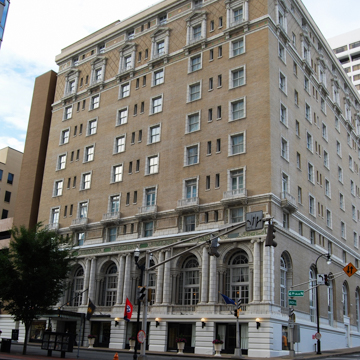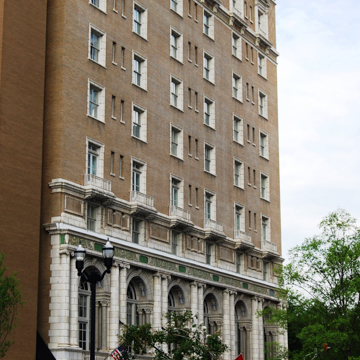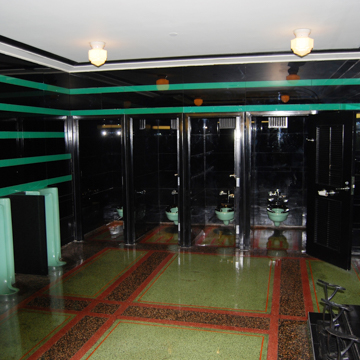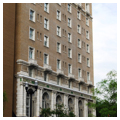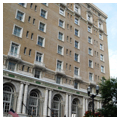Built to compete with Nashville’s three existing major hotels, the Hermitage Hotel was completed in 1910. Architect James Edwin Ruthven Carpenter designed the Beaux-Arts building to be sited on a prominent corner across the street from the Tennessee State Capitol. The terra-cotta detailing on the ten-story brick building added eye-catching appeal to the hotel, the only Beaux-Arts commercial building in downtown Nashville. Its location near the capitol made the hotel the scene of important political and social events. The hotel was named after President Andrew Jackson’s plantation.
The Hermitage Hotel Company was incorporated on June 5, 1908 with $350,000. Among the nineteen investors was Carpenter’s business partner and brother, John Carpenter, who invested $100,000. When it opened on September 17, 1910, the hotel advertised that it had 250 rooms finished in mahogany with hot and cold distilled water (to avoid typhoid) in all rooms; it was fireproof, had private baths, telephones, and electric fans. There were sample rooms on the eighth floor and an auditorium on the ninth. Rooms were $2.00 and up. The lobby boasted a stained glass skylight and vaulted ceilings. The Nashville Banner advertised the hotel as “Nashville’s magnificent $1,000,000 hostelry.” Nearly 400 guests were served dinner on opening night.
Peripatetic Tennessee native Carpenter (1867–1932) attended the University of Tennessee, the Massachusetts Institute of Technology, and the Ecole des Beaux Arts in Paris. In the late 1880s he worked in the office of McKim, Mead and White in New York City. Carpenter returned to Tennessee after the death of his father and published Artistic Homes for City and Suburb in 1892. When he finished the Hermitage Hotel project in 1910, Carpenter moved back to New York City and continued his practice there until his death in 1932.
When the hotel opened, unescorted women had to enter the hotel from a separate entry on Union Street and were not allowed in the loggia or the bar. Four years later, in 1914, the Hermitage Hotel hosted the National Woman Suffrage Association convention. Six years after that, with the ratification of the Nineteenth Amendment to the Constitution—giving women the right to vote—approaching the thirty-six states needed, the Hermitage Hotel became a battleground for both sides of the debate. Located near the state capitol, the hotel served as headquarters for both the suffragists, wearing yellow roses, and for anti-suffragists, wearing red roses. Representative Harry Burn of McMinnville, at one time sporting a red rose, changed his vote to pro-suffrage at the request of his mother. As a result of Burn’s vote, the state legislature approved the Nineteenth Amendment 49-47. On August 24, 1920, Governor Roberts signed the state’s ratification and Tennessee became the thirty-sixth and final state needed to ratify the Amendment.
State legislators could usually be found in the Hermitage Hotel lobby, restaurant, or bar when the state legislature was in session. The hotel hosted presidents beginning with Taft, and including Wilson, Roosevelt, Kennedy, and continuing to the present day. In 1941 Gene Autry and his horse Champion stayed in the hotel. Legendary pool player Minnesota Fats lived at the Hermitage Hotel for six years and had his own pool table on the mezzanine level.
The men’s restroom on the main floor was eventually redecorated in the Art Deco style with black and dark green glass tiles, terrazzo floor tiles, and pale green fixtures. This interior design is usually credited to William Caldwell, who managed the hotel in the 1940s.
Changing demographics in downtown Nashville and the construction of a newer and larger hotel adjacent to the Hermitage brought gradual decline in the 1960s and 1970s. The hotel closed in late 1970s and narrowly escaped demolition in 1977. Various schemes were planned to preserve the building, including one group of investors who planned to convert the Hermitage to an office building. Ultimately, it was reopened as a hotel and has been refurbished several times, most recently in 2002–2003.
References
Herndon, Joseph L. “Architects in Tennessee until 1930: A Dictionary.” Master’s thesis, Columbia University, 1975.
Marsh, Leonard E., “Hermitage Hotel,” Davidson County, Tennessee. National Register of Historic Places Nomination Form, 1975. National Park Service, U.S. Department of the Interior, Washington, DC.
“Hermitage Hotel Opening.” Nashville Banner, September 16, 1910. Reprinted in The Nashville Retrospect, September 2010.
Wills, Ridley III. The Hermitage at One Hundred: Nashville’s First Million Dollar Hotel. Franklin, TN: Providence House Publishers, 2009.





